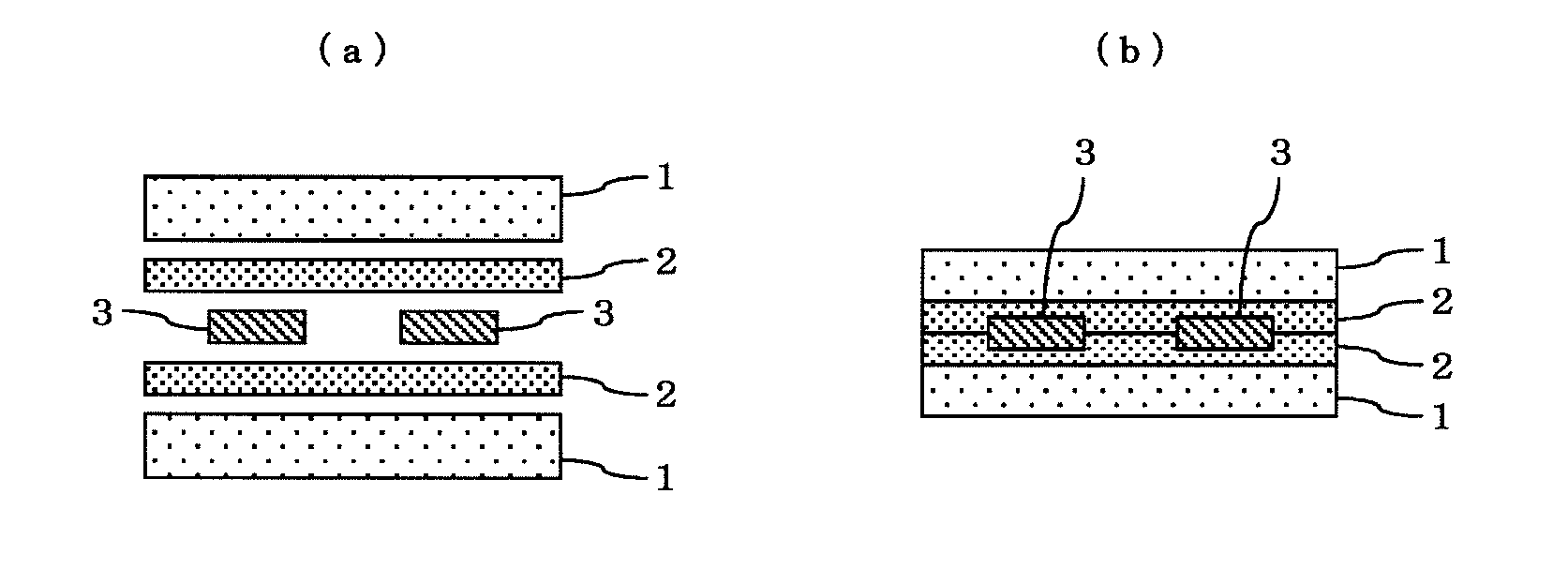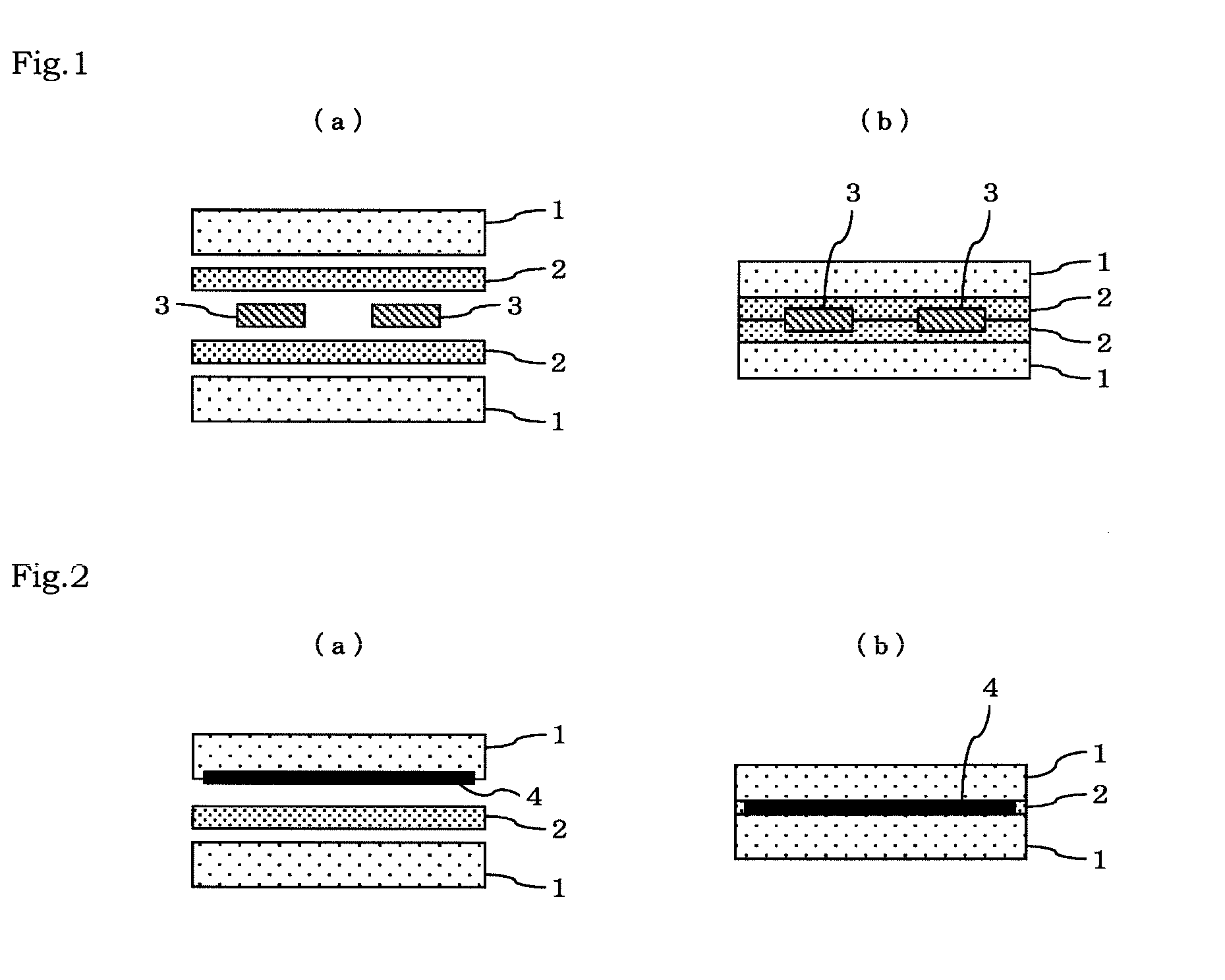Polyvinyl acetal laminate and use thereof
a technology of polyvinyl acetal and polyvinyl acetal, which is applied in the direction of water-setting substance layered products, synthetic resin layered products, transportation and packaging, etc., can solve the problems of poor adhesion between the plasticized polyvinyl acetal and the styrene-diene block copolymer, poor adhesion, and poor adhesion between the two polymers. , to achieve the effect of similar molecular
- Summary
- Abstract
- Description
- Claims
- Application Information
AI Technical Summary
Benefits of technology
Problems solved by technology
Method used
Image
Examples
synthetic example 1
Synthesis of Carbon-Carbon Double Bond-Containing Block Copolymer
[0152]To a 200 L pressure resistant vessel flushed with dry nitrogen, 60 kg of cyclohexane and 35 g of sec-butyl lithium as a polymerization initiator were added followed by addition of 2.9 kg of styrene. After polymerization at 50 to 52° C., 0.17 kg of THF was added and 26.2 kg of butadiene and 2.9 kg of styrene were added in order for polymerization. As a result, a styrene-butadiene-styrene type block copolymer was obtained. The block copolymer obtained was hydrogenated by using Pd / C (palladium carbon) in cyclohexane with hydrogen pressure of 2 MPa and reaction temperature of 100° C. to obtain the carbon-carbon double bond-containing block copolymer (polyolefin-1). The polyolefin-1 obtained has a weight average molecular weight of 100,400, styrene content of 18% by mass, and hydrogenation ratio of 97 mol % (content of the carbon-carbon double bond: 450 μeq / g). The results are shown in the Table 1.
synthetic example 2
Synthesis of Carbon-Carbon Double Bond-Containing Block Copolymer
[0153]To a 200 L pressure resistant vessel flushed with dry nitrogen, 60 kg of cyclohexane and 16.6 g of sec-butyl lithium as a polymerization initiator were added followed by addition of 1.45 kg of styrene. After polymerization at 50 to 52° C., 0.48 kg of THF was added and 13.8 kg of isoprene and 1.45 kg of styrene were added in order for polymerization. As a result, a styrene-isoprene-styrene type block copolymer was obtained. The block copolymer obtained was hydrogenated by using Pd / C in cyclohexane with hydrogen pressure of 2 MPa and reaction temperature of 100° C. to obtain the carbon-carbon double bond-containing block copolymer (polyolefin-2). The polyolefin-2 obtained has a weight average molecular weight of 83,000, styrene content of 16% by mass, and hydrogenation ratio of 92 mol % (content of the carbon-carbon double bond: 1,000 μeq / g). The results are shown in the Table 1.
synthetic example 3
Synthesis of Ultra Low Density Polyethylene Having Carbon-Carbon Double Bond in Terminal
[0154]To a separable flask, 200 g of ultra low density polyethylene having weight average molecular weight of 230,000 was added and heated for 30 min at 250° C. under vacuum. The temperature was further increased to 340° C. and heated for 2 hours to obtain the ultra low density polyethylene having carbon-carbon double bond in the terminal (polyolefin-3). The polyolefin-3 obtained has a weight average molecular weight of 80,000 and the content of the carbon-carbon double bond was 60 μeq / g. The results are shown in the Table 1.
PUM
| Property | Measurement | Unit |
|---|---|---|
| Percent by mass | aaaaa | aaaaa |
| Percent by mass | aaaaa | aaaaa |
| Mass | aaaaa | aaaaa |
Abstract
Description
Claims
Application Information
 Login to View More
Login to View More - R&D
- Intellectual Property
- Life Sciences
- Materials
- Tech Scout
- Unparalleled Data Quality
- Higher Quality Content
- 60% Fewer Hallucinations
Browse by: Latest US Patents, China's latest patents, Technical Efficacy Thesaurus, Application Domain, Technology Topic, Popular Technical Reports.
© 2025 PatSnap. All rights reserved.Legal|Privacy policy|Modern Slavery Act Transparency Statement|Sitemap|About US| Contact US: help@patsnap.com



